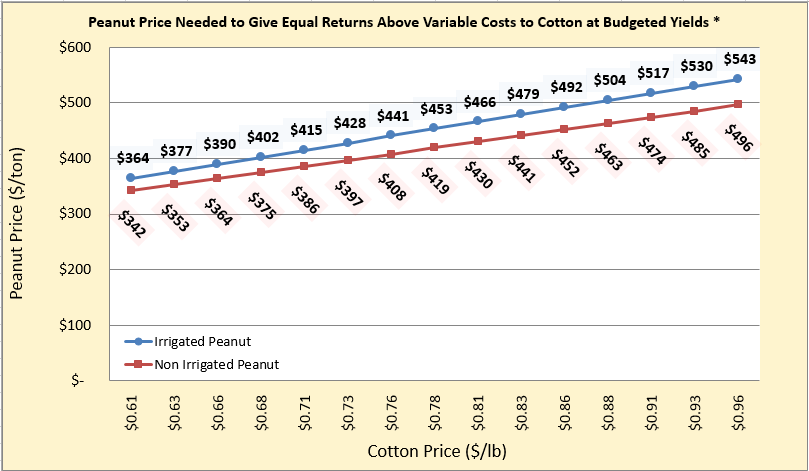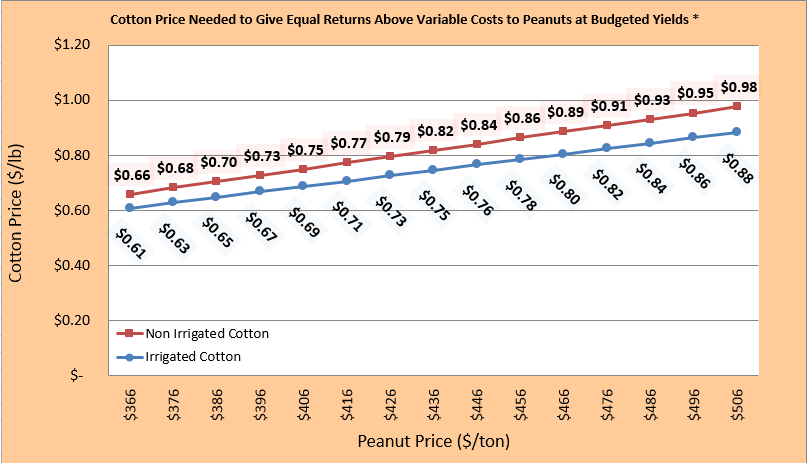
1) Irrigated peanut is compared to irrigated cotton and non-irrigated peanut is compared to non-irrigated cotton.
2) Irrigated peanut yield is 4700 lbs. and irrigated cotton yield is 1200 lbs.
3) Non-irrigated peanut yield is 3400 lbs. and non-irrigated cotton yield is 750 lbs.
4) Prices shown are those needed to cover budgeted operating costs for conventional till production listed in the crop comparison tool.
It’s February and time to make some real decisions about what to plant and how many acres to plant. Many factors go into determining the right fit for any producer, but the bottom line is profitability. To help producers make informed choices, it’s always good to look at enterprise budgets and crop comparison tools.
The University of Georgia Extension Economists have developed some very interesting spreadsheet tools that, while focused on crops and production practices of South Georgia, are also very useful for row crop producers throughout the Florida panhandle. Growers can look at cost comparisons of cotton, peanuts, corn, soybeans, grain sorghum, and wheat crop estimates based on conventional and strip till systems on irrigated or non-irrigated land. Growers can adjust the yields, prices, and costs on the spreadsheets to reflect their management and pricing situation. Other useful tools include a peanut price calculator that allows you, the grower, to input expected yield per acre, amount of pounds you contracted and the respective contract price, and the expectation of harvest price. The peanut price calculator should be used to calculate the true peanut price. Note there is a different price for irrigated and non-irrigated peanuts. This is because of an assumed contract based on a portion of yield rather than the entire production. The Price Comparison tool allows you to see, in graph form, equal returns above variable costs between corn, cotton, peanuts, and soybeans in strip till and conventional tillage systems.
To access this excellent resource, please see the updated website: 2014 Crop Comparison Tool. Direct access to the 2014 budgets, updated in February, which are the basis for the numbers in the crop comparison tool, can be found at the following links:
The PDF version is availabe to simply print and look over the information. You will not be able to change the numbers.
Use the Excel (.xlsx or .xls) files below if you want to change the numbers and plug in your own information to maximize the usefulness of this tool:
For computers with the latest editions of Excel: Microsoft Office Excel 2013 or 2007
-
Feb 14 UGA Crop Comparison .xlsx files
For computers with earlier editions of Excel: Microsoft Office Excel 2003 or earlier
-
Feb 14 UGA Crop Comparison .xls files
Alabama Extension also has some useful budget tools:

1) Irrigated cotton is compared to irrigated peanut and non-irrigated cotton is compared to non-irrigated peanut.
2) Irrigated cotton yield is 1200 lbs. and irrigated peanut yield is 4700 lbs.
3) Non-irrigated cotton yield is 750 lbs. and non-irrigated peanut yield is 3400 lbs.
4) Prices shown are those needed to cover budgeted operating costs for conventional till production listed in the crop comparison tool.
 0
0
